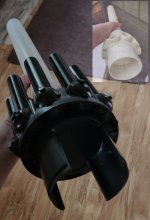Uh oh... I spoke too soon...
I went out today and noticed that I did not have the pump basket installed when I did the successful test yesterday. It continued pumping overnight at 1700 RPM without the pump basket, and today there was air under the dome (no water touching the dome). The skimmer basket and the floating weir were installed during the overnight period.
I did three tests below (all done at 3450 RPM and with skimmer basket and floating weir removed to reduced drag as much as possible; also I tightened pump the lid a little more when installing today):
1. I added the pump basket and ran for 10 minutes (still air at top of basket -- when pump turned off, water level was not on the dome, but just barely below it).

2. I removed the basket and ran for about 6 minutes or so (no air bubbles visible while running [1st picture], but when pump turned off, a smallish bubble accumulated at the top of the dome [2nd picture]):


3. I assumed there was some drag/head added by the pump basket that slowed down the flow rate enough to prevent the pump from removing all the air in the basket, so I decided to remove the flapper from the check valve (located on pressure side between the filter and the heater). I tested without the flapper but with the pump basket installed but this was of little help -- essentially same results as Test #1 above.
It does seem that there is still air getting in from somewhere, since there was air in the pump basket this morning, when yesterday there was none. Also, it seems that if air can be almost completely removed simply by removing the pump basket. Maybe the roughness of the pump basket prevents enough rolling turbulence in the basket area to prevent air bubbles from exiting the basket (or maybe the basket slows the flow rate). But still, new air is getting in it seems.
I was wondering... are there O-rings or seals inside the pump that could allow air to enter into the basket area while it is running? Any other ideas?

















